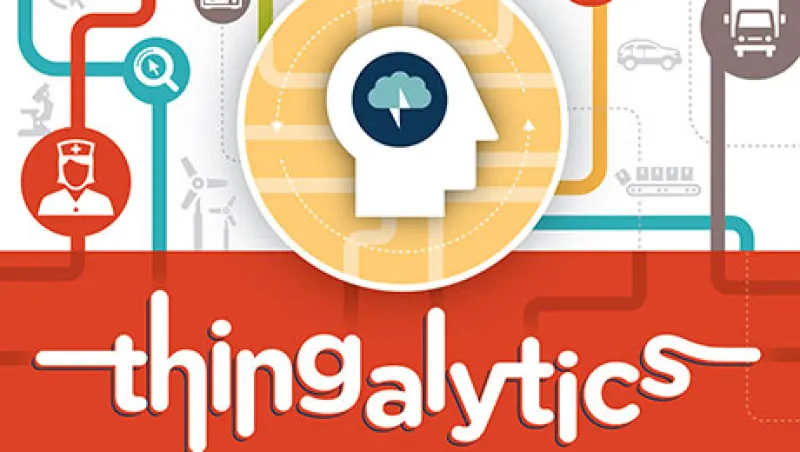By this point, most consumers and companies in the U.S. are relatively comfortable with the idea of “smart” objects. Even if we don’t refer to the home heating systems we can control by smartphone or TVs that learn what we like to watch as being part of the so-called Internet of Things, we are all starting to get the hang of everyday objects being digitized — just in time to learn that we are already falling behind on the next big idea: Thingalytics.
It’s the name John Bates, founder of real-time analytics firm Apama and current chief marketing officer and head of industry solutions at Software AG, has given to the act of gathering and analyzing the huge amounts of data being pushed out by digitized things every day. Bates has spent his career on the pioneering edge of digital technology, and his obsession comes through in Thingalytics: Smart Big Data Analytics for the Internet of Things, a short work recently published by Software AG that reads like a manifesto for harnessing the power of the Internet of Things to create positive change for both corporate and human interests.
The main goal of Thingalytics is to use all of the “fast Big Data” that is — and soon will be — rushing in through sensors on things like drink refrigerators in convenience stores, cars and machines in warehouses to track trends, prevent issues and make predictions. Many of its applications are noble — ensuring proper sanitation at hospitals, preventing massive capital markets fraud — but to someone not steeped in the cult of digital technology innovation, Thingalytics may seem a bit creepy.
In the introduction to the book, Bates describes the potential for nearby retailers to know when you’ve just made a purchase that might be complemented by something they offer, and to push a coupon to your smartphone. If you respond to that offer in this scenario, you could then receive, for example, an automatic coupon for a nearby restaurant. This could theoretically continue ad infinitum, until the customer changes his or her privacy settings. At least most of these consumer-facing apps are opt-outable; some Thingalytics implementations appear to give the customer less control. In another scenario Bates describes, a grocery store could track shoppers’ visual characteristics and even facial expressions whenever they walk past a sensor in order to show them targeted offers on nearby screens.
But even if the consumer-facing aspects of Thingalytics sound disturbing to you, Bates makes a pretty convincing argument that everyone can share in the benefits. In addition to helping companies maximize revenue opportunities, Thingalytics can help with security and fraud prevention, everywhere from the capital markets to hotels and to airplanes.
One of the biggest sells for this way of handling data is the fear of becoming uncompetitive. “Digital Darwinism is unkind to those who wait,” Bates writes, citing data that show retailers using Thingalytics could increase their operating margins by more than 60 percent. Financial firms in particular operate in a “winner take all” world, and being the first and fastest to master harnessing a fire hose of data will lead to winning results. According to Mike Gualtieri of Forrester Research, only 21 percent of companies were using some form of big data streaming analytics — a 61 percent increase from 2012, but still a small number.
The other most disruptive Thingalytics application may be its potential to both find new opportunities and prevent crises in the trading world. This is really Bates’s bread and butter, and he spends a good deal of the book explaining how proper gathering, handling and deployment of data through Thingalytics could forestall — or at least more quickly respond to — fat finger trades (mistyped orders) and flash crashes caused by rogue algorithms. The book also has a chapter on what Bates calls RoboCops, or regulatory policing systems that could learn to look for a certain combination of human actions — a trader chatting with someone they might not usually talk to, failing to take vacations, making a trade seconds before a news story is released — that could potentially predict criminal behavior. “Patterns can be discovered and crimes can be traced when monitoring and surveillance meet Thingalytics to form our own market RoboCop,” Bates writes.
The book is written with a mix of jargon and jovial, down-to-earth language — Bates is not afraid of exclamation points. And he’s anticipated some readers’ concern about algorithms becoming too intelligent and potentially making humans obsolete or, worse, prey. Sure, a mathematical formula known as VITAL (Validating Investment Tool for Advancing Life Sciences) has been given a seat on the board of a venture capital firm, but “we’re a long way from Skynet,” Bates tells Institutional Investor. And besides, with Thingalytics improving health care to the point of potential eternal life, Bates expects we’ll all need to move to other planets anyhow: “Otherwise, how will we all fit on Earth?”






